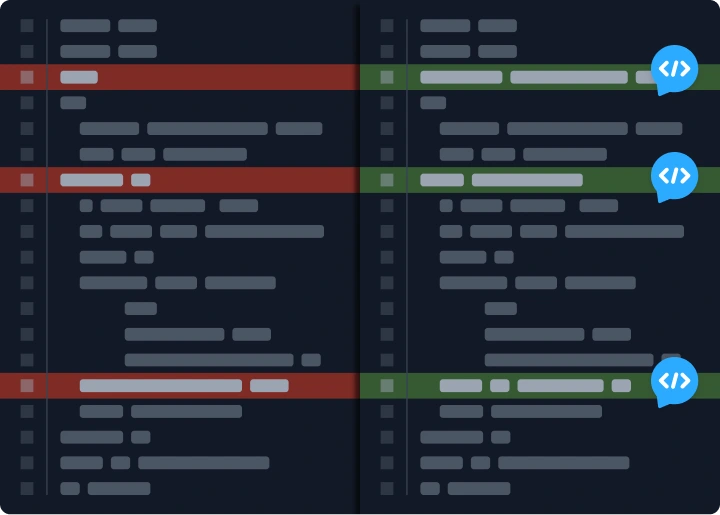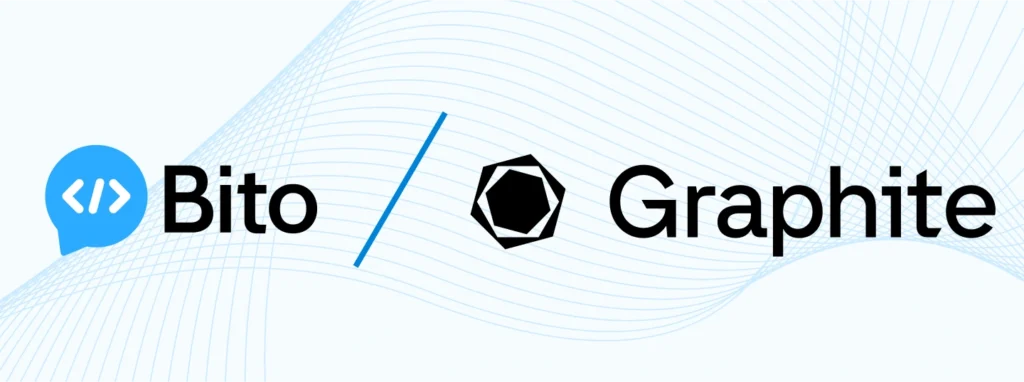Get high quality AI code reviews
- 90+ point analyses
- AI that understands your code
- Bito vs Graphite
Bito vs Graphite
Bito’s AI Code Review Agent and Graphite’s Diamond are both AI-powered code review tools that analyze code changes in pull requests and provide feedback, much like a diligent senior engineer would.
Both aim to speed up development cycles by catching bugs, improving code quality, and reducing the manual effort in code reviews. However, they differ in features, integration capabilities, pricing, and overall user experience.
In this guide, we’ll compare Bito and Graphite in depth to help you understand their strengths and choose the AI code review tool that best fits your needs.
Choosing the right AI code review tool
Evaluating AI-powered code review tools involves assessing how well they integrate into existing workflows, support team-specific standards, and enhance developer productivity without adding noise.
When evaluating AI code review tools, consider the following aspects:
- Contextual understanding: The tool should grasp the broader context of your codebase, not just isolated snippets.
- Integration capabilities: Seamless integration with your existing version control systems and development environments is crucial.
- Customization: The ability to tailor the tool’s behavior to match your team’s coding standards and practices.
- Security and compliance: Ensuring that the tool adheres to industry-standard security protocols and doesn’t compromise your codebase’s integrity.
- User experience: A user-friendly interface that provides actionable insights without overwhelming the developer.
With these criteria in mind, let’s explore how Bito and Graphite stack up.
Key differentiators of Bito's AI Code Review Agent

1. Chat with AI code reviewer
Bito enables you to ask questions directly to the AI Code Review Agent regarding its code review feedback. You can inquire about highlighted issues, request alternative solutions, or seek clarifications on suggested fixes.
This real-time collaboration helps accelerate development by providing immediate, actionable insights, reducing the back-and-forth delays common with traditional human reviews. Developers can resolve doubts on the spot, leading to faster, more accurate code improvements.
Graphite does not offer an interactive chat capability, making this a significant advantage of Bito’s AI Code Review Agent.
2. Integration with multiple Git providers
While Graphite is currently limited to GitHub repositories, Bito extends its support to GitHub, GitLab, and Bitbucket. This broader integration capability ensures that teams using diverse version control systems can seamlessly incorporate Bito into their workflows.
3. Granular review scopes with slash commands
Bito allows developers to tailor reviews to specific concerns using commands like /review security, /review performance, or /review scalability. This granularity ensures that feedback is relevant and focused, addressing the unique needs of each pull request.
4. Integrated feedback from dev tools you use
Bito strengthens its code review process by combining Large Language Models with a suite of specialized tools — including static analyzers, linters, secret scanners, and open source vulnerability checkers. This layered approach enables Bito to catch a wide range of issues, from type errors and potential null dereferences (with tools like MyPy and Infer), to style inconsistencies (via ESLint), exposed secrets like passwords and API keys (via secret scanning tools), and known security vulnerabilities in dependencies (using tools like OWASP Dependency-Check and Snyk).
In contrast, Graphite relies solely on its AI models without integrating any external scanning tools.
As a result, Bito’s comprehensive toolset allows it to detect critical issues — such as vulnerable dependencies or leaked secrets — that Graphite’s AI alone might overlook.
5. Flexible deployment options
Bito offers both cloud-based and on-premises deployment options, catering to organizations with specific infrastructure requirements or stringent data governance policies. Graphite, on the other hand, is primarily cloud-based without an on-premises alternative.
Side-by-side comparison

To provide a clearer picture, here’s a series of comparison tables focusing on different aspects of both tools:
1. Code review quality
| In-depth codebase understanding |
Supported languages Learn more |
|
| General code review |
Supported languages |
|
|
Integrated feedback from specialized dev tools (such as static analyzers, linters, secret scanners, and open source vulnerability checkers) |
|
|
| Custom code review rules |
|
|
2. Feature comparison
| Chat-based interaction | ||
| Integration with multiple Git providers (such as GitHub, GitLab, or Bitbucket) |
GitHub, GitLab, Bitbucket, GitHub (Self-Managed), GitLab (Self-Managed) |
Only GitHub |
| Pull request summary | ||
| High-level feedback | ||
| Review effort estimation |
Learn more |
|
| Continuous/incremental reviews | ||
| Inline suggestions with one-click to accept suggestions | ||
| Automated and manually triggered AI code reviews | ||
| Code review analytics | ||
| Comprehensive language support |
3. Code analysis
| Real-time code analysis using AI | ||
| Static code analysis | ||
| Open-source security vulnerabilities check | ||
| Secrets scanner (e.g., passwords, API keys, sensitive information) |
4. Security and compliance
| SOC 2 Type II compliance | ||
| Code is never stored, retained, or used for model training purposes | ||
| On-premises deployment |
5. Customization features
| Custom code review rules | ||
| Include/exclude files, folders, or Git branches from AI code reviews | ||
| Feedback mechanism for AI suggestions | ||
| Targeted analysis of specific aspects of code (such as security, performance, etc.) |
Learn more |
6. Performance metrics
| PR merge acceleration | 89% faster | Not specified |
| Reduction in regressions | 34% fewer | Not specified |
| ROI per dollar spent | $14 | Not specified |
7. Pricing
| Free plan available | ||
| Pro plan | $15 per user per month (billed monthly) |
$20 per user per month (billed monthly) |
| Enterprise plan | $25 per user per month | Custom |
8. Support and documentation
| Comprehensive documentation | ||
| Community support channels (such as Slack) | ||
| Dedicated support for enterprises |
9. Deployment options
| Cloud-based | ||
| On-premises |
Conclusion
Both Bito’s AI Code Review Agent and Graphite’s Diamond offer valuable features to enhance code review processes. However, Bito stands out with its chat-based code interaction, broader version control integration, granular review scopes, and flexible deployment options. These features provide developers with a more interactive and customizable code review experience.
As AI continues to evolve, integrating such tools into development workflows will become increasingly essential. Embracing these advancements not only boosts productivity but also ensures that codebases remain robust, secure, and maintainable.
